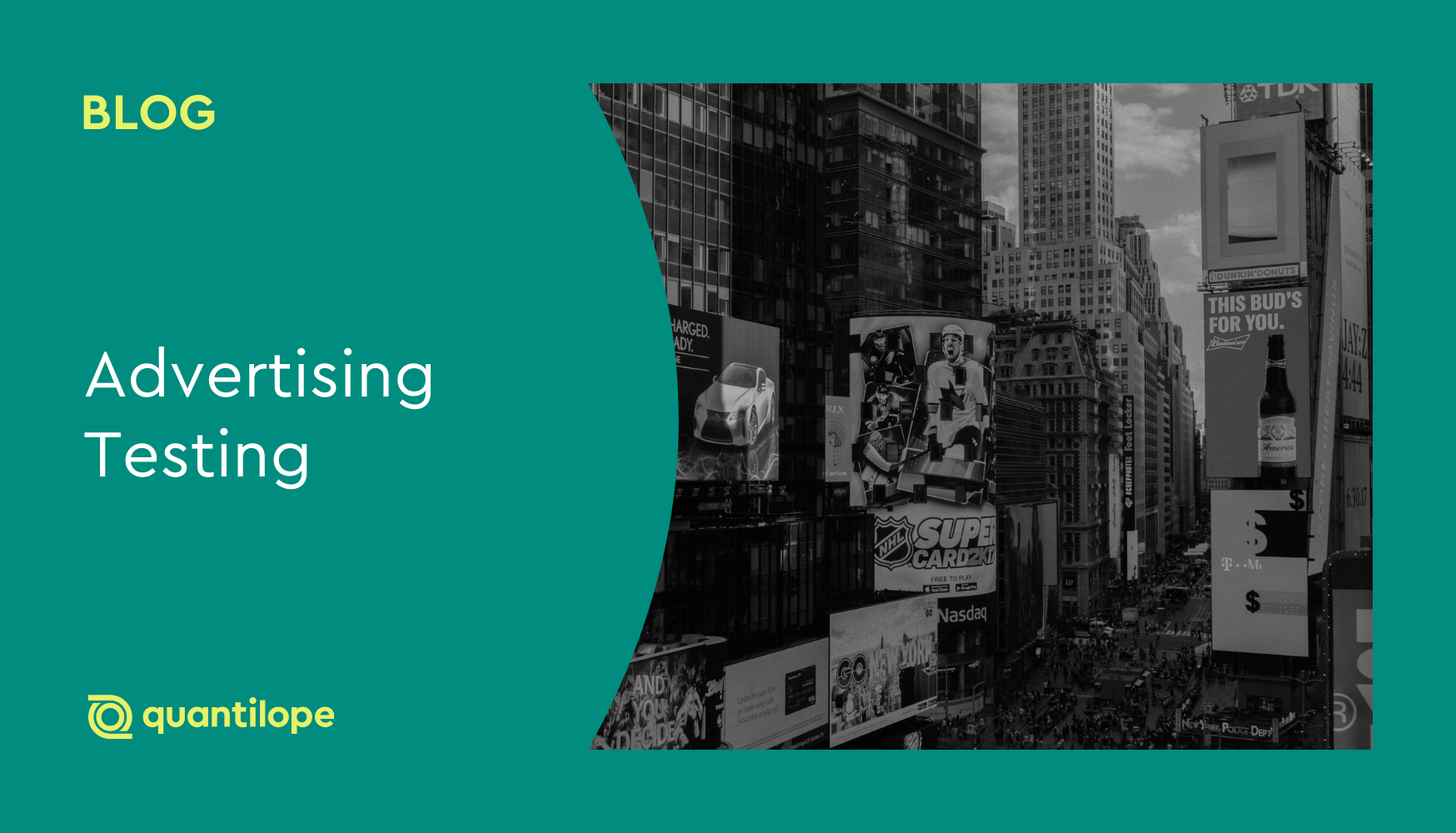Types of ad testing methods
There are several types of ad testing methods used in marketing and advertising at different points of the ad development process.
The methods below are commonly used to test an ad before setting it live:
Concept testing:
This method involves assessing the overall idea or concept of an ad before it is produced. It helps evaluate the relevance, appeal, and comprehension of the ad's creative direction.
Copy testing:
Copy testing focuses on evaluating the effectiveness of the written content or copy within an ad. It typically involves measuring factors such as readability, clarity, persuasiveness, and brand messaging.
A/B testing:
A/B testing (sometimes called split testing) is an ad testing method that involves creating multiple versions of an ad concept and testing them among different segments of your target audience. By comparing the performance and effectiveness of these different versions, advertisers can determine which version will likely perform better in the real market.
Pre-testing:
Pre-testing involves conducting research and gathering feedback on a completed ad before its official launch (which differs from concept and copy testing which test individual parts of the ad). You can pre-test an ad among a small audience before setting it live to the masses to confirm your creative choices hit the mark.
Eye tracking:
Eye-tracking technology is used to measure where individuals' eyes focus while viewing an advertisement. It helps identify the most visually engaging elements, the flow/path of attention, and potential areas for improvement in the ad's layout and design. This type of ad testing might also be used after an ad is live, to monitor what real consumers are actually paying attention to.
Neuromarketing ad testing:
Neuromarketing utilizes neuroscientific techniques such as brain imaging (fMRI), EEG, or biometric measurements to analyze consumers' subconscious responses to ads. It aims to understand emotional engagement, attention levels, and cognitive processing to optimize ad effectiveness. This is another type of ad testing that might also be beneficial to run on real consumers after an ad has gone live.
Back to Table of Contents
Once your ad is live in the market, you can use the following types of ad testing to measure its performance:
Post-testing:
Post-testing occurs after an ad has been launched, and its performance is evaluated through various metrics such as reach, impressions, click-through rates, conversions, and brand impact studies. These measurements help determine the ad's success and can provide insights for future campaigns.
Ad recall testing:
Similar to post-testing, ad recall is a form of ad testing done after an ad concept has been launched, to assess how well individuals remember seeing it after exposure. It might involve asking participants to recall specific details of the ad, key messages, or brand associations to evaluate the ad's memorability.
Social media listening:
With the rise of social media, advertisers can monitor conversations and consumer sentiments around their ads using social listening tools such as Brandwatch, Hootsuite Insights, or Sprout Social. This method of ad testing helps gauge public reactions and engagement levels, providing valuable feedback for refining ad strategies going forward.
Back to Table of Contents
How to run ad testing
The below steps outline how to go about testing ads, from the design stage, to setup, vendor selection, and actual testing:
1. Design your ads
Of course, the starting point for ad testing is having something to actually test; this can be a still image, a series of images, or a fully developed commercial spot. The format of your testing concept could be images of digital advertising, printed copy, audio content, videos, or billboards. Whatever it is, it‘s wise to check for the following aspects before you put it into research testing:
- A hook: An idea, theme, or message that grabs your audience’s attention so that they feel compelled to watch or read through right to the end to find out what the advertising is all about. At the beginning of advertising or copy, there might be a question for which the consumer needs to wait for the answer: for example, ‘This is the single biggest mistake people make when buying travel insurance.’
- Engaging visuals and voiceovers: To grab attention, hold attention, and help memorability of your message, you need engaging visual and audio components. Make sure that images are clearly linked to your brand, and that any copy or voiceovers mention your brand too, ideally more than once. The last thing you want is people thinking your ad is for a competitor brand (or, not knowing at all who the ad might be for).
- A clear message: Focus on the key idea you want to get across and don’t include too many messages about your product. For example, ‘90% of people said they would buy our insurance again’ implies reliability and customer satisfaction, so that you don’t have to list each benefit of your product.
- The right language: This might mean changing the tone or words you use across countries and by customer segment. Segments could be based on exposure to advertising, life stage, gender, or some other demographic. If you don’t already have this customer knowledge, consumer profiles can be determined through market research segmentation done prior to ad testing.
- Honesty: It’s tempting to include overly optimistic claims about how your product will turn the consumer’s life around. But unless done in an ironic and knowing way, unrealistic messages will put customers off rather than encourage them to check out your product.
- A USP - Unique Selling Point: Tell your target market how your brand is different from the competition. Why buy your product rather than competitor products?
- A clear call to action (CTA): You’ll need to decide what you want your audience to do as a result of seeing your ad. Do you want them to call you, find out more online, go to a specific store and buy your product? Whatever it is, tell them at the end of the advertisement what they should do and how they should do it.
2. Decide what you want to test
Once ads have been designed, there may well be several potential avenues of executing them. Do you go with a serious or silly tone? Loud or soft audio? Celebrity or athlete cameo? All different options may feel interesting and persuasive, but which will the target audience prefer?
Further, there are then different parts of the marketing mix to consider: social media ads, TV ads, print advertising, and many more. Additional research can elicit reactions to each format and help you ensure consistency across them. A TURF analysis is particularly useful for understanding which avenues of advertising will result in the optimal audience reach.
There’s also the option to include your previous ads or competitor ads to benchmark reactions. This will highlight whether your new advertising is in line with previous campaigns, on which measures it does better or worse, and how it stacks up against the competitive set.
When you’ve decided which stimuli (the ads you’re testing) to put into research, it’s time to plan which elements of the ads you would like to test and which metrics you will use to evaluate how successful they are.
3. Choose the metrics to measure
The success of an ad hinges on its ability to meet a selection of criteria. If one criterion isn’t fulfilled, the ad can fall short. You’ll therefore need to ensure that your research methodology allows respondents to score, rate, or give reactions to a range of metrics, including:
- First impressions: Does the ad give off the right vibe from the start?
- Standout: Does the ad have a ‘wow’ factor when up against competitor ads?
- Appeal: Do respondents like the ad? Do they like the message?
- Clarity: Is the main message clear? What do respondents understand it to be?
- Engagement: Does the ad hold people’s attention? Or did respondents look/click away?
- Believability: Do people believe the claims in the ad?
- Relevance: Is the product or service being advertised one that fits into the audience’s lives?
- Brand fit: Does the ad match with perceived brand image and values?
- Uniqueness: Is the ad idea original and unique?
- Call to action: How high is purchase intent after seeing the ad?
Beyond closed-end metrics such as the above, ad testing research can also capture spontaneous feedback from consumers (through open-end texts or through qualitative research) so that all possible criticism or praise is included in the final analysis of the ad’s performance.
4. Pick market research software
You have your ads, and you know what you want to measure, so now you‘ll need to find a way to measure it.
There are a few ways to test advertising effectiveness. One of the best quantitative approaches is A/B testing, also known as monadic testing. This method shows each of the advertisements being tested to separate groups of respondents, each group equally structured in terms of respondent criteria (demographics, purchase behavior, and whatever else is deemed to be important in the sample quota). Each group sees just one ad. The advantage to this single exposure is that respondents can give their full attention to a single ad, survey length is kept to a minimum, and therefore response rates will likely be higher.
A variation on this method is sequential A/B testing, in which each group of respondents sees multiple ads and can make comparisons between them. This does make the survey longer for each respondent and there can be an order bias in responses. However, it typically demands a smaller sample than single ad tests, which could make them more cost-effective.
Beyond quantitative research, you might want to gain more emotional, nuanced reactions to your ads using qualitative research. Qualitative responses tend to be more spontaneous, and respondents go into more detail explaining the reasoning behind their reactions which can pinpoint how ads need to be changed to elicit the desired response. Qualitative research can be done via focus groups, in-depth interviews, or online methods such as video research.
5. Create the test/survey
When your advertisement(s) are ready to test on your chosen market research software or platform, it’s time to decide who you will show it to and which questions you will ask.
The respondent sample should be representative of your target audience and statistically significant so that you can rely on the findings with confidence. Any good research service will help you define your sample’s profile and size. It will also guide you through the questions you‘d want to include in your survey and the style to use (e.g. scales, select-all, open text fields).
In terms of constructing the survey, make sure each ad receives the same amount of attention from respondents, with the same set of questions asked of each so that fair comparisons can be made. Also ensure that the ads you’re showing are as high quality as possible so that they can be easily evaluated and give the best possible impression of your brand.
Back to Table of Contents
Choosing the right platform or service for ad testing
Advertising testing needs to be done well. After all, you have a lot riding on your ad performance - brand awareness, brand image, and brand equity, not to mention - profitability. When looking for an ad testing service to use, make sure it‘s one that can help you with survey design, sample allocation, and high-quality research and analysis to deliver findings that feed into your final creative development.
With quantilope's online Consumer Intelligence Platform, you get more than just an ad testing service or tool. Rather, you get full control of your ad testing from start to finish with dedicated support from classically-trained research consultants (in as much or as little capacity as you need). quantilope’s intuitive drag-and-drop functionality enables you to upload stimuli and choose the research method most suited to your ad testing study, such as a fully automated quantitative A/B pre-roll test. Once your research goes live, you can watch results populate in real-time, with findings displayed visually on quantilope’s live, interactive dashboard. You'll be able to see how your ads perform according to key metrics, helping you to optimize messaging and advertising styles for future ad campaigns.
If you‘d prefer to go the qualitative research route, quantilope‘s inColor tool gathers responses in video form so that you can see and hear consumers talk about the ads and analyze their responses using keyword, emotion, and sentiment analysis.
To learn more about how quantilope can help optimize your advertising campaigns for maximum effectiveness, get in touch below!





.png)